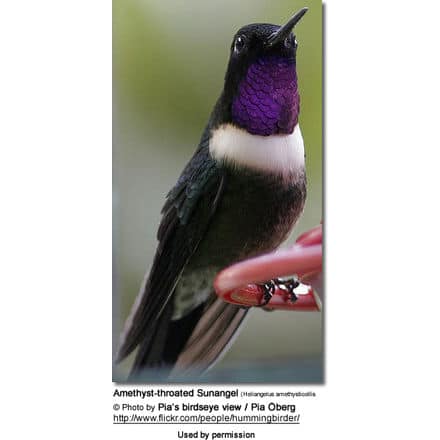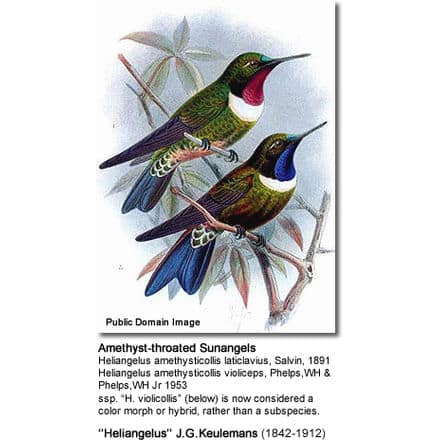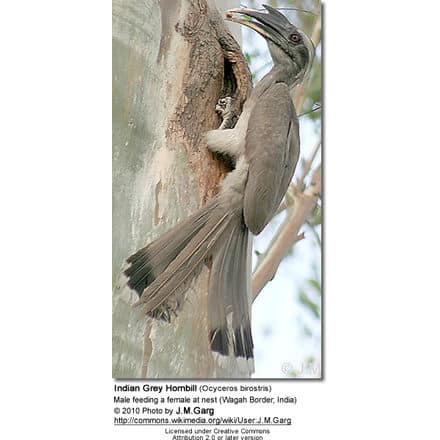Amethyst-throated Sunangels
The Amethyst-throated Sunangels (Heliangelus amethysticollis) are South American hummingbirds that are fairly common within their range. In fact, they are the most widespread of all sunangels.
This species was named for the iridescent, amethyst-colored throat patch of the male.
Distribution / Habitat
Amethyst-throated Sunangels occur naturally in the countries of Bolivia, Ecuador and Peru, where they typically occur at higher elevations – from 5,900 – 10,500 feet (1,800 – 3,200 meters) and west of Rio Maranon.
They inhabit wet and humid montane forests (cloud and elfin forests), and – to a lesser extent – occur along the edges of forests, in bushy second growth and open bushy terrain along streams, as well as being found on humid grassy slopes.
They are often active around mixed flocks.
Subspecies and Ranges:
- Heliangelus amethysticollis amethysticollis (d’Orbigny and Lafresnaye, 1838) – Nominate form
- Range: Eastern Andes in southern Peru and northwestern Bolivia.
- Heliangelus amethysticollis laticlavius (Salvin, 1891)
- Range: Southern Ecuador and northern Peru – north and west of Marañón Valley
- ID: The forecrown is glossy blue-green. Some females may have a purple gorget, similar to but smaller than those of males.
- Heliangelus amethysticollis decolor (Zimmer, 1951)
- Range: Eastern Andes in central Peru (south of the Marañón river).
- ID: The forecrown is glossy blue-green.
Alternate (Global) Names
Chinese: ????? … Czech: kolib?ík bolivijský … Danish: Ametyststrubet Solalf … Dutch: Amethistzonnekolibrie, Merida-zonnekolibrie … Finnish: Ametistienkelikolibri … French: Héliange à gorge améthyste … German: Amethystsonnennymphe … Italian: Angelo del sole di Merida … Japanese: shiroeritenshihachidori … Norwegian: Amestystsolengel, Ametystsolengel … Polish: lordzik purpurowogardly, lordzik purpurowogard?y … Russian: ????????? ????? … Slovak: nymfárik bieloprsý … Spanish: Ángel Gorgiamatista , Colibrí Gorgiamatista … Swedish: Ametistsolängel
Description
The Amethyst-throated Sunangel measures 3.7 – 4.5 inches (9.4 – 11.5 cm) in length and has a bill that is between 0.6 – 0.73 inches (1.5 – 1.8 cm) long.
The straight, short bill is about 0.7 inches or 18 mm long.
Both genders have a broad white or buffy-white crescent across the chest.
Adult male: He has a glossy purple or purplish-blue throat patch (gorget), which may look darkish in poor light conditions. The forecrown ranges from glossy blue-green to green (ssp. clarisse).
Adult Female: The throat in most females is dull brown or rusty colored freckled blackish; however, some may develop a small glossy purple throat patch – particularly in subspecies laticlavius.
Similar Species: Orange-throated Sunangel and Gorgeted Sunangels.
Calls / Vocalizations / Sounds
Their calls are described as dry, ringing trills.
Breeding / Nesting
Amethyst-throated Sunangels usually breed between May and August.
Hummingbirds are usually solitary in all aspects of life other than breeding; and the male’s only involvement in the reproductive process is the actual mating with the female. They neither live nor migrate in flocks; and there is no pair bond for this species. Males court females by flying in a u-shaped pattern in front of them. He will separate from the female immediately after copulation. One male may mate with several females. In all likelihood, the female will also mate with several males. The males do not participate in choosing the nest location, building the nest or raising the chicks.
Hummingbird Resources
- Hummingbird Information
- Hummingbird Amazing Facts
- Attracting Hummingbirds to Your Garden
- Hummingbird Species
- Feeding Hummingbirds
The female is responsible for building the cup-shaped nest out of plant fibers woven together and green moss on the outside for camouflage in a protected location in a shrub, bush or tree. She lines the nest with soft plant fibers, animal hair and feather down, and strengthens the structure with spider webbing and other sticky material, giving it an elastic quality to allow it to stretch to double its size as the chicks grow and need more room. The nest is typically found on a low, skinny horizontal perch.
The average clutch consists of two white eggs, which she incubates alone, while the male defends his territory and the flowers he feeds on. The young are born blind, immobile and without any down.
The female alone protects and feeds the chicks with regurgitated food (mostly partially-digested insects since nectar is an insufficient source of protein for the growing chicks). The female pushes the food down the chicks’ throats with her long bill directly into their stomachs.
As is the case with other hummingbird species, the chicks are brooded only the first week or two, and left alone even on cooler nights after about 12 days – probably due to the small nest size. The chicks leave the nest when they are about 7 – 10 days old.
Diet / Feeding
The Amethyst-throated Sunangels primarily forage in the understory of humid forest or along the forest edge.
They feed on nectar taken from a variety of brightly colored, scented small flowers of trees, herbs, shrubs and epiphytes. They favor flowers with the highest sugar content (often red-colored and tubular-shaped) and seek out, and aggressively protect, those areas containing flowers with high energy nectar.








